Last Updated on July 25, 2022 by
I had heard about the vibe and feel of different energy at Kamakhya temple Guwahati – something that was indescribable. So I went to take Kamakhya Devi blessings myself and I cannot recommend it enough for everyone to go!
Among the places to visit in Guwahati, visiting the Kamakhya mandir is a must!
Table of Contents
About Kamakhya Temple Guwahati
The 9th century Kamakhya temple holds significance because it is one of the Shakti Peeths (significant shrines and pilgrimage destinations). The temple has a residing deity – Goddess Kamakhya, known to be a reincarnation of Goddess Durga. The temple is considered to be one of the most important Hindu pilgrimage spots in the country.
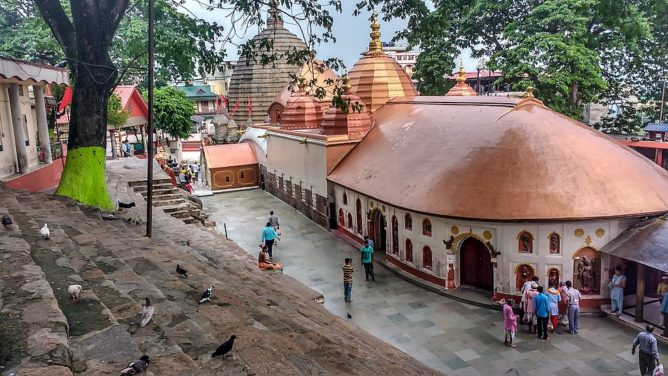
Kamakhya Devi Story
It revolves around the Hindu gods Shiva and Sati.
King Daksha, father of Sati, organized a great yajna, where he invited all the deities, gods and sages but consciously excluded his son-in-law Shiva to insult him.
Hurt by her father’s decision, Sati decided to visit her father and demand the reason for not inviting them. When she entered Daksha’s palace, she had to listen to the insults directed towards the Shiva. Unable to bear anything against her husband, a devastated Goddess Sati threw herself in the glowing sacred fire of yajna.
When Shiva came to know of what had happened, his anger knew no limits. Carrying his wife’s burnt corpse, he went on a rampage with his ‘Tandav‘ or the dance of destruction. While all other gods cowered in fear under Lord Shiva’s rage, Lord Vishnu using Sudarshan Chakra cut Sati’s body, in order to calm the aggrieved deity.
These pieces fell on earth at various places and came to be known as Shakti Peeths. All these 51 places are considered to be holy lands and pilgrimages.
Architecture of Kamakhya Temple
The temple consists of four chambers: one garbhagriha (inner sanctum) and three mandapas (pillared hall).
These mandapas are generally aligned from east to west. The temple has a beehive-like structure which is very characteristic of lower Assam. The Kamakhya temple essentially follows the Nagara style of architecture of North India. The sculptures are apparent mostly on the exterior walls as well as on the interior walls of the temple. A few sculptures also exist on the temple gates.
The western mandapa is large and rectangular and is not used by the general pilgrims for worship. The middle mandapa is square, with a small idol of the Goddess. The walls here contain sculpted images of Naranarayana, related inscriptions and other gods. The middle mandapa leads to the sanctum sanctorum of the temple.
Significance of Kamakhya Temple
The feminine divinity in Hinduism, Shakti (power), is considered to be the greatest creative force in the universe. Kamakhya is a celebration of this ‘shakti’ within every woman, the shakti to create life by giving birth.
The Kamakhya temple is associated with feminine sexuality, fertility and the very origin of all living beings which is why the deity Kamakhya Devi is fondly called the bleeding Goddess. The sexual organs of Shakti are present in the sanctum sanctorum and worshiped by devotees.
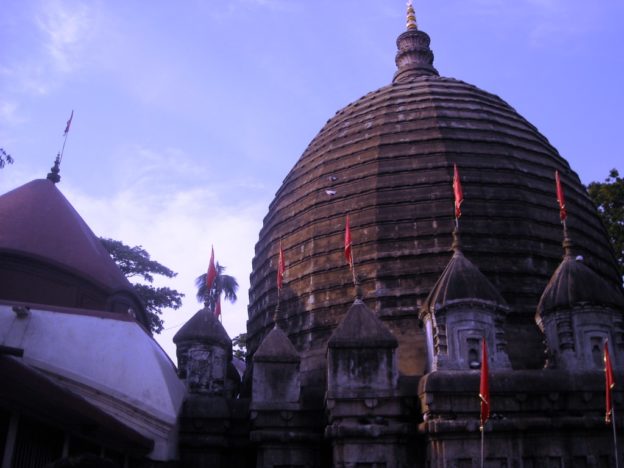
Most important Festivals and Celebrations around Kamakhya mandir
Ambubachi Mela is one of the most important festivals celebrated during the monsoon season. This takes place in mid-June which is the celebration of the yearly menstruation course of goddess Kamakhya. The temple is closed for 5 days and opens on the 6th day with grand fervor. It is said that the Brahmaputra river turns red during these 5 days.
Another annual celebration is the Manasha Puja. Durga Puja is also celebrated annually at Kamakhya during Navaratri in the autumn.
My experience at Kamakhya temple Guwahati
I reached the temple premises at 7:15 am, much before the opening of gates at 8:00am. Walking through the approach road surrounded by shops selling puja items, souvenirs and sweets to be offered, I refused to turn my neck towards the sides and ignored the calls of the shopkeepers. I walked straight to the temple.
I was not sure at this point as to what to expect while visiting the Kamakhya temple. The temple was already packed with devotees wanting to pay their respects to Maa Kamakhya.
There were clearly two queues (just like most temples) where one queue was paid also called ‘VIP Darshan’ and the other one was free. VIP Darshan queue is a paid queue wherein you can reach the inner temple. The fee is Rs. 500 per person and it takes between 2-3 hours to reach. The other queue is free and could take 5-6 hours to reach the inner sanctum. Since I was in a time crunch I chose the paid queue.
During the waiting time I couldn’t help but notice the number of goats in the temple premises.
These goats were brought here for tantric (black magic) purposes that is to sacrifice a life to appease the god in exchange of something desirable for the human being. I have absolutely detested this concept of exchange of life for a worldly pleasure and do not believe that it works – after all all lives exist on earth with God’s permission. There were baby goats and chickens with red tika on their forehead. There were dozens of pigeons with gulal (red powder) on their bodies fluttering around. I found this to be weird for a temple complex since such scenes are not commonly seen anywhere.
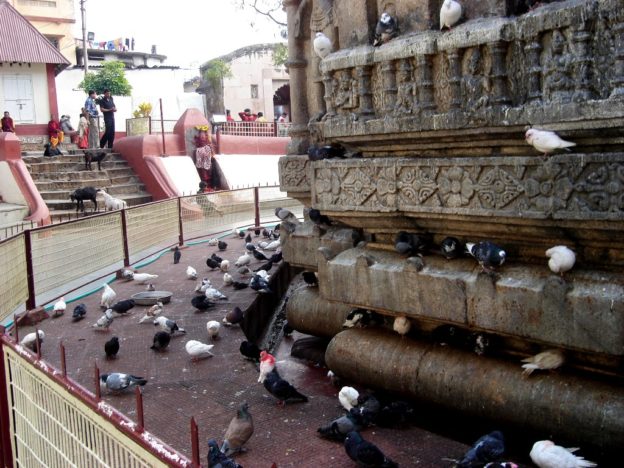
Moving at a snail pace, somewhere around 10am, that is 2 hours after the gates opened, I was finally close to reaching the inner sanctum or garbhagriha – the main part of the temple.
It is a small cave below the ground level. I climbed down steep rock steps in order to reach the garbhagriha. The steps width is small which made it possible for only two people to pass and the entire area was pitch dark. There were only a couple of lamps providing the light and I had to make my way to the deity.
The garbhagriha has no image or sculpture, but a Yoni or a vagina-shaped rock fissure which is the main deity.
It was completely covered with flowers and other offerings so I could not see its shape or tell if it resembled a vagina. People were allowed to touch this rock and women were encouraged to touch the rock by the priest.
This rock fissure was wet with a small pool of water and people touched it and then patted their forehead with it. I even saw a few take a quick sip from their hand. The fissure gets filled via an underground natural water spring.
I climbed back those steep steps to come out of the complex. I was in the inner sanctum for probably less than 2 minutes and I felt extremely claustrophobic and anxious because of the dark and crowd. No, I did not feel any different vibe or energy – just people pushing each other and the priests shouting instructions so that the crowd moves quicker just like I had experienced in Trimbakeshwar Temple.
Best time to visit Kamakhya Temple Guwahati
Month wise, Guwahati is pleasant during winters so it is best to visit then. Time wise, afternoons are the best to visit the temple to avoid the crowds.
The Kamakhya temple timings are open 8:00 am to 1:00 pm and 2:30 pm to 5:30 pm everyday except during Ambubachi festival.
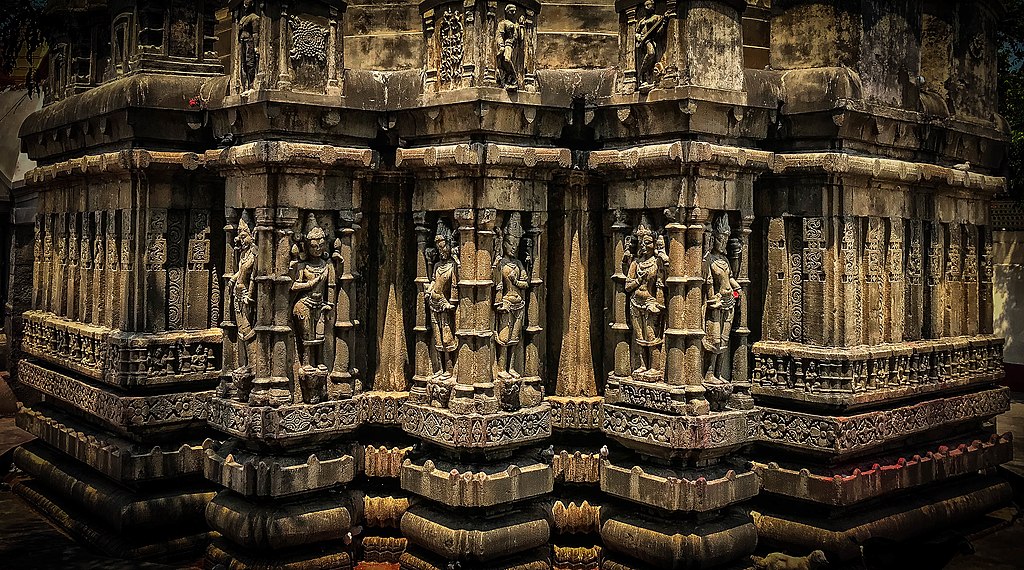
Kamakhya Temple Location
Kamakhya Temple is located on Nilachal Hills in the western part of Guwahati near the Guwahati Railway Station and around the Brahmaputra river. While the main temple is of utmost importance, the temple is located in a complex which consists of several temples. There are temples of 10 Mahavidyas in and around the temple.
How to reach Maa Kamakhya Temple
Being one of the important shrines in the city, Kamakhya temple Guwahati is easily accessible from anywhere in the city. Autos, private taxis as well as Ola and Uber are easily available even at 5 am to reach the temple.
Is Kamakhya temple Open right now?
With the ever changing COVID-19 guidelines by the Assam state and the country it is best to check before going. More details can be found on their official website.
Sustainable tips to visit Kamakhya Mandir
- Like every Hindu temple, devotees are not allowed to wear shoes. Do not wear socks as the premises have many areas with water and gulal. The inner sanctum also is wet due to the natural spring.
- Respect the Hindu culture and do not wear clothes that show too much skin. Cover your shoulders and knees.
- Keep your mobile phone away while entering the temple sanctum.
- Throw your garbage in the dustbins located at the entrance of each temple.
- Priests in the temple may offer to conduct some puja or push you to touch something and then demand money. Gently fold hands and do not touch anywhere or talk to the priests unless you want to conduct a sacrifice or puja or abhishek.
- Keep away from the place where they conduct ‘bali’ or tantric puja of sacrificing goats. It may be disturbing for some.
Do Indian temples fascinate you? Read about Chidambaram Temple or Modhera Sun temple.
Disclaimer: This article includes affiliate links. It means it adds no extra cost to you if you book through the link but I get a referral bonus which helps me earn a little to keep this website up and running.
Pin this post!
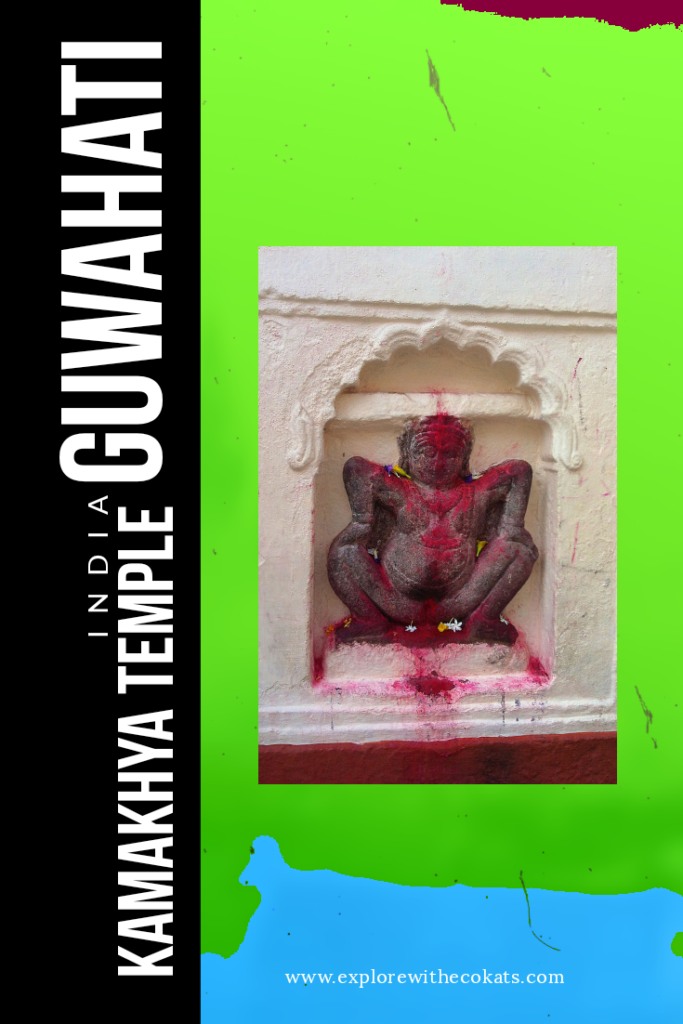

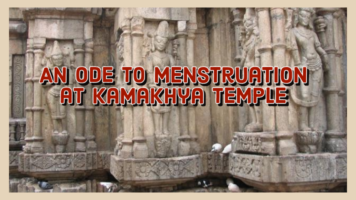
5 comments
Beautifully described. Thanks for sharing your raw and honest experience. From what i’ve read, when Vishnu cut Sati’s body into 51 pieces, the part with reproductive organs dropped here where Kamakhya temple was raised. And apparently the ground water turns red once a year(i dont blv it happebs naturally). Fascinating stories indeed.
That’s quite a different temple from what I’ve seen before. Interesting!
Wow. What an interesting place.
This looks so interesting!
I didn’t know this temple existing, but would definitely pay a visit to it 🙂
This reads so fascinating! I would love to visit. India has the most unusual temples – dedicated to rats, motorcycles, menstruation and probably so much more. Thank you so much for sharing, I have added this to my “to visit” places as I would love to return to India on a longer trip.